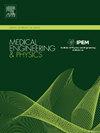与实验研究相比,三维生物传热图揭示了纳米磁性微粒在射频热疗乳腺癌治疗中的有效性
IF 1.7
4区 医学
Q3 ENGINEERING, BIOMEDICAL
引用次数: 0
摘要
射频(RF)热疗已被广泛用于肿瘤消融,因为磁流体热疗(MFH)可作为热疗的补充方法用于提高肿瘤区域的温度。在这项研究中,通过使用生物热传递图确定三维温度分布,评估了在射频热疗中使用磁铁矿纳米颗粒(Fe3O4)治疗乳腺癌(BC)的有效性。在不同状态下(含纳米磁铁矿和不含纳米磁铁矿),将带有肿瘤区域的乳房假体置于频率为 13.56 MHz 的射频设备中。同时,通过 COMSOL 软件中的数值模拟和有限元法(FEM)完成了射频波和生物热方程的计算。通过实验测量了模型不同点的温差,精度为 0.1 °C,肿瘤区域在无纳米磁性和有纳米磁性条件下的温度分别为 3.6 °C和 6.1 °C,正常区域在无和有 0.05 gr 磁铁矿条件下的温度分别为 1.8 °C和 1.9 °C。此外,模拟结果与实验结果的差异为 0.54-1.1%。在肿瘤和正常区域进行的实验和模拟研究的温度测量结果一致,这表明在组织等效的乳房模型中应用 MNPs 进行射频热疗是有效的。最后,0.05 克 MNPs 对 BC 治疗的积极作用得到了证实。本文章由计算机程序翻译,如有差异,请以英文原文为准。

3D bioheat transfer mapping reveals nanomagnetic particles effectiveness in radiofrequency hyperthermia breast cancer treatment comparing to experimental study
Radiofrequency (RF) hyperthermia has been widely used for tumor ablation since magnetic-fluid-hyperthermia (MFH) can be utilized for increasing temperature in tumor-region as a complementary-method for hyperthermia. In this study, the effectiveness of using the magnetite-nanoparticles (Fe3O4) in RF hyperthermia for breast cancer (BC) treatment by determining 3D-temperature-distribution using bioheat-transfer-mapping was evaluated. A breast-phantom with a tumor region was placed in an RF-device with 13.56 MHz frequency in different states (with and without-nanomagnetite). Parallelly, the calculations of the RF-wave and bioheat-equation were accomplished by numerical-simulation and finite-element-method (FEM) in COMSOL-software. The temperature differences were experimentally measured at different points of the phantom with a precision of 0.1 °C, with temperature of 3.6 °C and 6.1 °C in without and with nanomagnetic conditions in tumor area, respectively, and also for normal area with temperature of 1.8 °C and 1.9 °C in non-presence and presence states of 0.05 gr magnetite for both conditions, respectively. Moreover, the difference between the simulation and the experimental results was 0.54–1.1 %. The conformity between temperature measurement in experimental and simulation studies in tumor and normal areas showed the effectiveness of the application of MNPs for RF hyperthermia in tissue equivalent breast phantom. Finally, the positive effect of 0.05 gr of MNPs on BC treatment was confirmed.
求助全文
通过发布文献求助,成功后即可免费获取论文全文。
去求助
来源期刊

Medical Engineering & Physics
工程技术-工程:生物医学
CiteScore
4.30
自引率
4.50%
发文量
172
审稿时长
3.0 months
期刊介绍:
Medical Engineering & Physics provides a forum for the publication of the latest developments in biomedical engineering, and reflects the essential multidisciplinary nature of the subject. The journal publishes in-depth critical reviews, scientific papers and technical notes. Our focus encompasses the application of the basic principles of physics and engineering to the development of medical devices and technology, with the ultimate aim of producing improvements in the quality of health care.Topics covered include biomechanics, biomaterials, mechanobiology, rehabilitation engineering, biomedical signal processing and medical device development. Medical Engineering & Physics aims to keep both engineers and clinicians abreast of the latest applications of technology to health care.
 求助内容:
求助内容: 应助结果提醒方式:
应助结果提醒方式:


